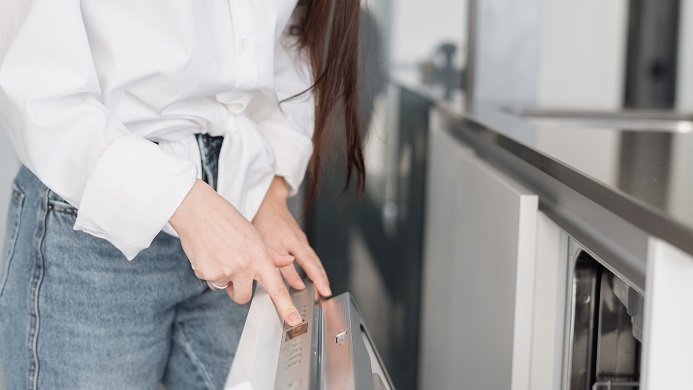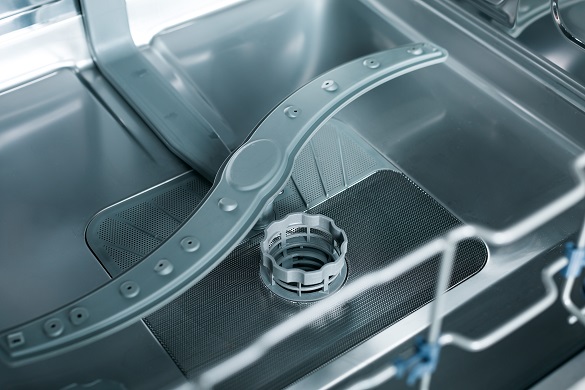
How to clean your dishwasher
If it’s not cleaned regularly, your dishwasher can become smelly from grime and mildew build-up. Learn how to thoroughly clean all the areas of your dishwasher.
Get 20% off* your next protection policy
We’re always looking for ways to make life easier for our valued customers and now more than ever we want to help you keep your home running smoothly.
You can get 20% off* your next policy for the first 12 months as a thank you for protecting your appliance with us.
*Excludes tablets, boilers and mobile phones. Products must be in good working order, more than 3 months and less than 8 years old. You cannot cancel the policy and then purchase another policy to protect the same item within 12 months of the original policy purchase date. Prices will revert to standard rates at the end of the first 12 months of the policy. Note, some policies have an excess.
Prefer to watch?
Why clean your dishwasher?
Your dishwasher has hot water and detergent sloshing around it already – so doesn’t it just clean itself during a cycle?
Of course, your dishwasher does clean itself to some extent. That’s why it doesn’t need cleaning after every cycle.
However, if you never clean it then things can start to go wrong. Some parts should get a scrub every week, while others can wait a month or six months.
The reason it needs cleaning is the food debris that can hang around in the machine, leaving a residue. If you live in a hard water area then limescale will also develop. Over time these things can block the dishwasher filter and the spray arms. This will stop your dishes getting all the water they need. Ultimately, it could also lead to mechanical problems that need a dishwasher repair.
How often should you clean your dishwasher?

How often you should clean your dishwasher depends on how frequently you use it. For this article, we’ll assume that you run your dishwasher once a day. If you use it more often, you should probably clean it more often too.
- Weekly: clean out the filter and wipe the door seals
- Monthly: top up the dishwasher salt and rinse aid
- Every six months: clean the spray arms and run the dishwasher on an empty hot cycle
If you can, it’s a good idea to check for any food debris after every wash and empty the filter. You might even find that a piece of cutlery has fallen into the bottom, for example. You don’t want that rattling around while the machine is running
What to use to clean your dishwasher

The good news is, you don’t need a lot of special stuff to clean your dishwasher. Beyond the standard household cleaning products, all you’ll need to buy is some dishwasher cleaner.
Here’s what you might need:
- A kitchen scrubbing brush
- An old toothbrush or similar
- A kitchen cleaning cloth
- Kitchen cleaning spray
- Dishwasher cleaner
You may have heard advice about using acids like lemon juice or white vinegar instead of a specialist dishwasher cleaner. While this may work, there’s a risk of damaging the rubber parts of your dishwasher. It’s best to follow what the manufacturers recommend, and spend a little more on a trustworthy cleaning product.
Step-by-step guide to cleaning your dishwasher
Cleaning your dishwasher isn’t a huge chore — you can do it in just a few minutes each week. Here we’re going to cover six steps, but you don’t need to do them all at once.
1. Familiarise yourself with your dishwasher

Before starting to clean, it’s best to know the parts of your dishwasher and how to reach them. The parts of a dishwasher that typically need cleaning are:
- The detergent dispenser
- The door seal
- The spray arms
- The racks
- The silverware basket
- The filter
Have a look in your dishwasher to identify these parts. If you’re not sure, there will be a diagram in the dishwasher’s manual.
2. Empty the dishwasher

Most dishwasher cleaners need the machine to be empty before you run the cleaning cycle. Always check the instructions on the dishwasher cleaner before using it, though.
3. Run a hot cycle

Check the instructions on your dishwasher cleaner first. Most cleaners need to be used in a hot wash of 60 °C or more to give the best results.
Doing a hot cycle for cleaning is particularly important if you tend to use eco cycles for washing. This is because an eco cycle is colder than a regular cycle, so it doesn’t remove bacteria as well.
4. Wipe or scrub the interior and door seals

Cleaning the door seals once a week will remove any food stuck on there. Caked-on stuff on the seals can cause them to crack and break eventually, which will lead to leakage.
It only takes a minute to wipe the door seal with a damp cloth, then you’re done.
5. Remove and clean the dishwasher filter

The filter is usually in the middle of the dishwasher’s floor. It often consists of a metal plate with holes in it, and a plastic cylinder.
Take out the bottom dish rack and you should see the top of the filter in the metal plate. You can pull the cylinder out by twisting or pulling, depending on your model, and the metal plate should come out after.
To clean the metal plate, run it under the kitchen sink tap. For the cylinder, you can also use a soft brush on the inside.
6. Check and clean the dishwasher arms

The spray arms are responsible for directing water at your dishes. The arms have a number of small holes which can get clogged up with food parts or limescale. If this happens, your dishes aren’t going to get as clean.
The spray arms are simple to remove on most models of dishwasher. Once they’re off, you can poke any gunk out of the arm holes and rinse them under the tap.
7. Wipe down the exterior and control panel

For plastic exteriors, simply wipe the outside of the dishwasher with a cloth and a mild kitchen spray. Dishwashers with stainless steel on the outside may need a special cleaning product. Be careful not to use anything harsh or abrasive on the dishwasher.
Tips for keeping your dishwasher clean
Prevention is better than cure, and simple maintenance is preferable to a deep clean. By following these tips you can get peak performance from your dishwasher and keep it in the best possible shape.
Remove leftover food debris after every cycle
One of the easiest ways to help your dishwasher run smoothly is to watch what you put in it. Remember to scrape or rinse any solid food before putting the plates in. This will help avoid build-up and blockages.
Then when you’re unloading after the cycle, take care to check the bottom of the dishwasher and remove any debris. That way, it isn’t a whole new chore that takes up more of your time.
Use rinse aid and dishwasher salt

Dishwasher salt is most needed if you live in a hard water area because it softens the water. Without dishwasher salt, hard water will leave crusty limescale on your filter and could damage the mechanism over time.
Rinse aid is more of a cosmetic product — it helps to stop water marks forming on your dishes. Again, this is particularly useful in hard water areas.
If you need to clean limescale from any part of your dishwasher, you can use a specialist cleaning product. Or you can use an acidic solution like vinegar diluted in water, to soak any removable parts.
Don’t block the dishwasher arms
Most dishwashers have two spray arms — one above the top rack and one below the bottom rack. If you put a large pot right under or over these arms, it will block the water coming out. Then the surrounding dishes won’t get washed like they should.
Remove labels from items before washing
You might be tempted to remove labels from new items by putting them in the dishwasher. This isn’t a good idea, because the label might not dissolve completely and may just stick to the filter or leave bits all over your machine which can build up and leave you needing a dishwasher repair.
To be safe, remove any labels by hand first. If they are stubborn, you can try soaking them in hot water. There are also cleaning products specifically for removing glue and labels, or you can try using something like WD-40.
Leave the door open after each cycle
It’s best to leave the dishwasher’s door open for a little while after running a cycle. Keeping it shut creates a warm, damp environment that’s perfect for mould and other microbes to flourish.
If mould does develop, you can clean it away with bleach. If you have a stainless steel dishwasher though, use a bleach-free detergent.
Leaving the door open will also avoid any unpleasant smells. To combat any existing smells, sprinkle some bicarbonate of soda inside it before running a cycle.